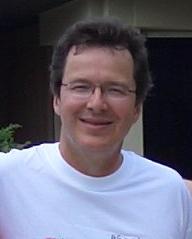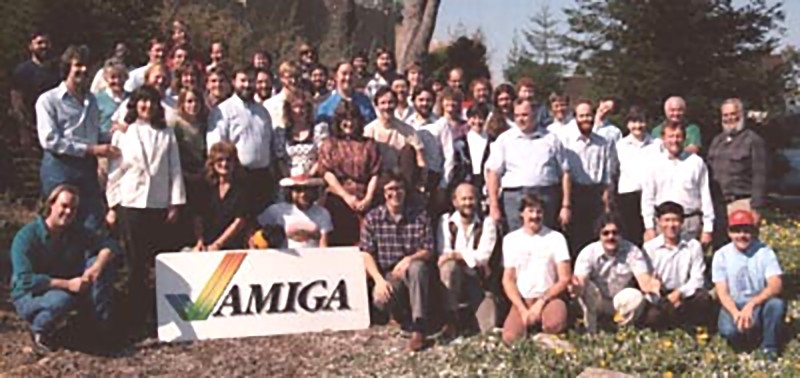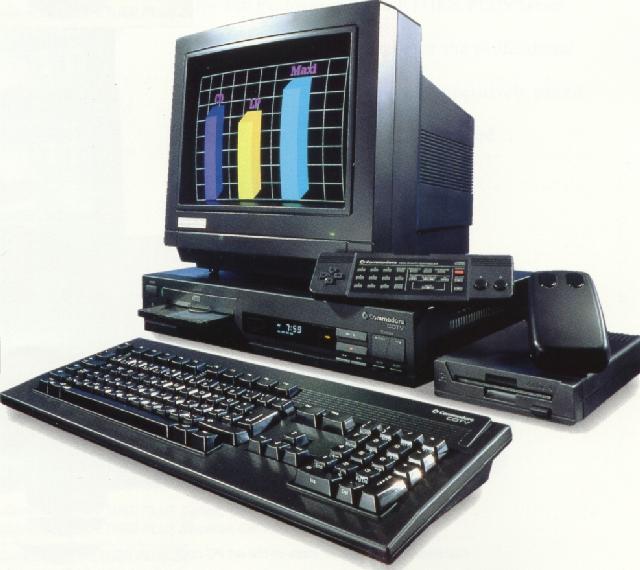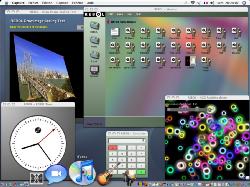 |
Dimanche 19 octobre 2025 - 02:22 |
| Translate |
|
| Rubriques |
| Réseaux sociaux |
|
| Liste des jeux Amiga |
|
| Trucs et astuces |
|
| Glossaire |
|
| Galeries |
|
| Téléchargement |
|
| Liens |
|
| Partenaires |
|
| A Propos |
|
| Contact |
|

|
|
To celebrate the 1000th article of Obligement, Carl Sassenrath returns through this long interview on its origins at Amiga Inc. in the 1980's (Manager of AmigaOS and Amiga CDTV system development, among others), the bankruptcy of Commodore, its passages at Apple Computer and Viscorp, Amiga NG, or on its new revolutionary language REBOL. A great name of Silicon Valley !

 Carl, first some private information : can you
introduce you (age, family, hobbies) and give us some words about your studies and jobs before 1983 and Amiga Inc.?
Carl, first some private information : can you
introduce you (age, family, hobbies) and give us some words about your studies and jobs before 1983 and Amiga Inc.?This year I will turn 50 years old.
In 1988, I moved away from the busy Silicon Valley to the peaceful mountains of Ukiah, California, about 170 Km north of San Francisco. I live on SassenRanch with my wife Cindy, my three children, a dog, three cats, various chickens, turkeys, and wild animals of many kinds.
On SassenRanch we grow grapes for fun, not for profit. Our grapes are the French type, Cabernet Sauvignon and Merlot, that we harvest, ferment, and make into wine each year.
We enjoy boating and wakeboarding on a nearby lake. I am also very interested in solar power (we live in a solar house), amateur radio, and photography/video. And oddly, these days my most passionate hobby is quantum electrodynamics. My whole life, I have wanted to understand it. It is a difficult subject, but a noble goal.
 Why and how did you join Amiga Inc. in 1983?
What was your mission in the team?
Why and how did you join Amiga Inc. in 1983?
What was your mission in the team?In 1983, I was working as a software engineer for Hewlett Packard where I was creating new graphical user interfaces concepts based on the latest ideas: bitmapped displays and mouse input.
A friend interviewed for a job at a small startup called Amiga, and I had just interviewed for a small startup called Symantec. My friend did not get the job and suggested that I consider Amiga, and I told him about Symantec.
The next day, the Amiga VP of Software called my house, and I was not home. My wife talked to him. She thought he was rude on the phone, so she did not want me to go interview at Amiga. I told her that at least I should go see what it was about, and I immediately drove down to visit Amiga. Within two hours, I was offered the job as Manager of Operating Systems.
I took the job at Amiga for 2 reasons : 1) it was obvious to me that the hardware concepts were very advanced, and 2) they offered me the chance to develop any kind of OS that I wanted. I had been working many years on my own multitasking concepts, so Amiga was a chance to make that into reality.

The Amiga team in 1985
 Can you give us some words about the ambiance and
climate inside the original Amiga Team (before Commodore) and especially about Jay Miner?
Can you give us some words about the ambiance and
climate inside the original Amiga Team (before Commodore) and especially about Jay Miner?Amiga was a very busy place, and we were all excited about the amazing system. It was a dream-come-true for many of us.
The Amiga office was very small and there was not much space to work. The software team had one room and the hardware team had another. In between, there was a lab were the prototypes were constructed and tested.
In the hardware room, Jay was always busy working at his desk, with Mitchie sitting nearby. Jay was serious and focused, but he did have a good sense of humor.
There were many times when a few of us from the software team would go over and try to convince Jay and the hardware team to add a feature to the Amiga. Sometimes they would make the change, other times not. For example, Dale Luck was able to get changes to the blitter, or I got changes for Paula, etc. These were small changes compared to the magnitude of the overall hardware project, but it made the team happy to work together, and sometimes the hardware people would come to us to put something into software rather than hardware (such as the method of floppy disk encoding). It was truly a great team.
After Commodore bought Amiga Corp, we moved to a much larger office and purchased much better development equipment.
 In 1980's, why were so innovative the Amiga computer
(hardware and custom chips) and its Operating System (AmigaOS and Exec)?
In 1980's, why were so innovative the Amiga computer
(hardware and custom chips) and its Operating System (AmigaOS and Exec)?The innovation came from the spirit of the Amiga development team. We wanted to change the world of computers. We all knew that the Atari, Commodore, and Apple II computers were just toys, and each of us on the team wanted to build a more powerful system.
We worked day and night for seven days a week to make our dream a reality. We watched closely the development of the Macintosh over at Apple, and we would gather as much information as possible about it (of course, it was quite different from Amiga). In fact, Andy Hertzfeld himself came to visit Amiga one day, and he and I had a very long chat about the designs of our operating systems and how we had our priorities. At the heart of the Mac was an advanced memory usage model, while at the heart of Amiga was true multitasking.
It is interesting that later, when I went to work for Apple, they asked me what it would take to make the Mac into a pre-emptive multitasking system. I told them "you cannot retrofit multitasking." This is true because all existing applications would have serious problems if they were being pre-empted. It was not until OS X, more than a decade later, that they finally achieved it.
 What were your other projects and works at
Commodore/Amiga (languages, systems, Amiga CDTV,...)? Amiga CDTV was not really a success, why?
What were your other projects and works at
Commodore/Amiga (languages, systems, Amiga CDTV,...)? Amiga CDTV was not really a success, why?After Amiga was released, I left the company because I was disappointed by some of the things I saw happening. There was talk about making the Amiga PC compatible, and I thought that was a big mistake. I was also worried that the Amiga may not be marketed properly.
Within a month after leaving Amiga, Irving Gould (chairman of Commodore) called me at home and for a several hours urged me to return to Amiga. I asked if he could have the head of Commodore marketing fly out to California to meet with me to talk. I will never forget that meeting. We had lunch in Cupertino, directly across the street from Apple Computer. I said, "Right there (pointing to Apple) is a company that knows how to market computers. Commodore must do the same. How are you going to make that happen?" His answer was not clear. He did not have the Amiga passion, and I told Irving that I would not return to Amiga.
However, for a several years I continued to work on Amiga projects, writing the first SCSI hard disk device driver, doing a tools for EA (Electronic Arts), creating the Amiga Logo language, writing the Guru's Guide, etc.
In 1989, I was very serious about the potential of CD-ROM and multimedia, and I was contacted by Commodore to help build CDTV. I managed the system software part of the project and also wrote all of the CDROM related code for it, as well as the tools for creating and testing CDROM content.

The CDTV
But, CDTV was ahead of its time and was marketed the wrong way. Commodore didn't really know what to do with it, and the price was too high to be a home game machine. Unfortunately, by the time CD32 (an excellent system) came out, it was too late for Commodore.
 What did change with Commodore (business,
technical and strategic choices)? Why the bankruptcy in 1994?
What did change with Commodore (business,
technical and strategic choices)? Why the bankruptcy in 1994?Like many companies, Commodore had lost track of what had made them a success. At the time they purchased Amiga Corp, they were the largest computer maker in the world. They had sold more than five times as many computers as IBM, Apple, and all the rest combined.
But, and I really do not like saying it, when Jack Tramiel left to go take over Atari, the top management of Commodore lost their way and tried to make Commodore into a business computer company. That kind of transition was very difficult, and they did not have the marketing ability to make it happen.
In addition, internally although Commodore was developing many important advances to the Amiga, such as 24 bit color, full CD sound, faster CPU, networking, and so much more, those improvements were very slow to be made into real products. So, Commodore started to lose the interest of many of the technical and artistic consumers who had helped make the Amiga a success.
I should note for the record that Irving Gould, the chairman of Commodore still believed in the original vision of Commodore, and it is the reason that CDTV became such a high priority. We used to joke that the main CDTV development team was Irving Gould, Don Gilbreath, and myself. We were in constant communication, and the project happened very quickly as a result (of course, there were many others who helped make CDTV happen). But, even then, without the proper marketing focus, it was Commodore was quickly heading downhill.
 What do you think about the new Amiga NG :
AmigaOne/AmigaOS 4 and Pegasos/MorphOS? Are you interesting and do you guess they will have future?
What do you think about the new Amiga NG :
AmigaOne/AmigaOS 4 and Pegasos/MorphOS? Are you interesting and do you guess they will have future?It is difficult to know for sure. Six months ago I attended the AmiWest show to find out more. OS4 looks very cool from the demos that I saw, but there was a lack of quality hardware to run it on. I asked many questions at the show and found that the general attitude of users was that there was no viable Amiga hardware available ! The hardware either did not work properly, could not get finished and delivered, or was too expensive. Most users were quite disappointed.
Of course, to me the hardware exception seems to be Genesi, which in fact sent me a working system that was well constructed. However, it only had Linux running, so I have never actually used MorphOS or OS4. It would be quite interesting if that hardware could run AmigaOS 4, but I do not have the time to experiment to get it running (and, I know that there are serious legal issues between the various related companies. That is too bad, but it is reality).
 You also worked for Apple Computer (after Amiga,
in 1986), what was your role at the Advanced Technology Group?
You also worked for Apple Computer (after Amiga,
in 1986), what was your role at the Advanced Technology Group?After Amiga, I went to work at Apple Computer for a couple of years, as did several other Amiga engineers. But, Apple did not have the same excitement as Amiga. Steve Jobs had just left Apple, and the company was then being run by a Pepsi Cola executive. He was a good guy, but was no Steve Jobs.
At Apple, it was interesting to see what engineers thought of the Amiga. Most of them thought that the Amiga would totally destroy Apple. Technically, Amiga could have, but they did not know what I knew about Commodore marketing.
My job at Apple ATG was to design the next multitasking OS - to become the successor to the Macintosh. The overall project was quite similar to the Amiga, but with about 10 times more money for development. We were building a quad-core CPU chip that ran nearly the speed of a Cray supercomputer. Like Amiga, the hardware team was great. Unfortunately, at that time Apple was not a good place to get products finished. There were far too many meetings and not enough focus. It was very frustrating to me. I eventually decided that the project would never be completed, and I left the company to move to the mountains in the north, far from Silicon Valley. Six months later, the project was canceled, and the OS team spun off to start a new company called Taligent.
 What was your job at Viscorp (in 1990's) and your
relationship with Bill Buck?
What was your job at Viscorp (in 1990's) and your
relationship with Bill Buck?I was in charge of developing the Viscorp OS for their TV set-top box, ED. After that, Viscorp had the chance to become the new Amiga, but they did not have the funding to make that happen. For many months, there was a lot of talk, and not enough action. I felt that the company was not being truthful to the Amiga community.
I did not work directly for Bill. But, I do believe he wanted Viscorp to be successful with the Amiga. There were just too many external factors involved to have a good outcome.

 In 1996, why did you decide to develop the new
language REBOL? What are its specifications and advantages? Why is it so innovative and a revolution for you?
In 1996, why did you decide to develop the new
language REBOL? What are its specifications and advantages? Why is it so innovative and a revolution for you?I had been working on my own language concepts since the days before Amiga Corp ! In fact, when I left Commodore/Amiga, I spent much of my time on language development. Since the late 1970's I had enjoyed studying languages and learning all of languages of that time. Over the years, I built several compilers and interpreters. The first one I wrote was a language for HP in 1980.
Over the years from 1980 to 1996, I watched carefully as new languages were released. I hoped that each would be the language that I had envisioned. But, all the languages were just spin-offs of other designs. There was not much new or innovative about them. So, in 1996, after watching Java be released a year earlier, I decided it was time to release my own concepts.
The main idea of REBOL is to make a language that is extremely advanced and powerful, but at the same time very small and easy to deal with. REBOL achieves those goals.
As a simple comparison example, a language like C has 5 primitive datatypes (integer, float, char, etc). By comparison, REBOL 3 as 58 primitive datatypes. That factor gives REBOL an entirely new dimension of expression. And expression is what language is all about. But, that is just one small aspect of REBOL. I picked it here because it is easy to explain. REBOL introduces several other dimensions of expression.
One of my primary reason for designing REBOL was to solve the problem of how you share information and processing between many different computers at the same time. I call this the "distributed computing problem". I think the special properties of REBOL solve this problem better than any other language.
 How many employees and engineers are working at the
moment on REBOL (at REBOL Technologies)? What is for you the most important application/software ever developed with REBOL
(which shows all the power of the language)? Can you give us some great companies using REBOL?
How many employees and engineers are working at the
moment on REBOL (at REBOL Technologies)? What is for you the most important application/software ever developed with REBOL
(which shows all the power of the language)? Can you give us some great companies using REBOL?RT (REBOL Technologies) is a small company. We have six people, but the REBOL community provides us with a lot more capability, and in the future with REBOL 3.0, that will become an even more important factor.
I think right now, the most important application is QTask. It is an incredible organization and project management system. In addition, the AltME messaging system and REBOL/IOS are also important products for REBOL, and part of our future. But, I should also mention that there are a good number of developers who have created a wide range of interesting and useful applications.
REBOL has been used by many large companies and organizations, including companies like AMD (chips), Lockheed Martin, ING, US Government, and many others. I do not keep track of that anymore, because I care more about what individual developers and technical people want. If REBOL we can solve their problems, then it can gain greater attention and the adoption it needs to become a larger success.
 What will be the changes in the new REBOL 3.0?
When will it be launched?
What will be the changes in the new REBOL 3.0?
When will it be launched?There are many advancements in 3.0. It would take many pages to list them all.
One of the main goals for REBOL 3 is to make many parts of it open source so that it can be supported on a greater number of hardware and software systems without RT needing to do all that. Now developers can help bring REBOL into new products and markets.
Note however, there will still be a kernel of REBOL that is not open source. This factor lets us keep the language 100% compatible between different computers and operating systems. We want there to be one central place that anyone can go to download (yes, for free) the REBOL system and its components and applications.
 REBOL/View was also available on Amiga 68k until
version 1.2. But you have stopped to support the Amiga platform since version 1.3. Do you think you will port REBOL on
AmigaOS 4 and/or MorphOS in the future (it would be a great chance for these systems)? Do you have contacts with
Hyperion Entertainment for an AmigaOS 4 port and with Genesi for a MorphOS port?
REBOL/View was also available on Amiga 68k until
version 1.2. But you have stopped to support the Amiga platform since version 1.3. Do you think you will port REBOL on
AmigaOS 4 and/or MorphOS in the future (it would be a great chance for these systems)? Do you have contacts with
Hyperion Entertainment for an AmigaOS 4 port and with Genesi for a MorphOS port?Various developers of those systems have contacted us to help, but until 3.0, it was not easy for them to contribute. Now with 3.0, outside developers can help get REBOL running properly on whatever Amiga configuration they want to support. The requirement is that any such code be uploaded and available from the REBOL website to allow all developers and users to benefit from such advances.
 Don't you think that REBOL is not enough popular
and don't you need more marketing to promote REBOL? Do you guess that a new name will really change something? How do
you imagine REBOL in the future?
Don't you think that REBOL is not enough popular
and don't you need more marketing to promote REBOL? Do you guess that a new name will really change something? How do
you imagine REBOL in the future?Ah, well that is a part of my talk for the REBOL DevCon in Paris, 10 and 11 may 2007.
It should be noted that the success of a language is not easily improved by money alone. Java took billions of dollars to get where it is today, but languages like Ruby have taken no money at all !
What it takes to succeed is to constantly attract new developers and users. For that to happen a language cannot be on its own; it must be part of a system of some kind. For example, C was the language of Unix. Perl was the language for web servers. PHP was for server-side scripting. There are many examples. That's what makes a language popular - the end solution.
I think the name of the language is not that important. For programmers, the name REBOL is fine and we will keep that. For businesses, we will find an appropriate "marketing brand" to help them recognize that REBOL is a good thing.
So, the grand vision of REBOL is that it must be a part of something much bigger than just a language. We proved that with REBOL/IOS. It was very powerful. Our plan is for REBOL to be the heart of programming a new type of virtual-OS that can span not only our office computers, but also our home systems, mobile devices, web browsers, web servers, and more.
And, of course, my ultimate goal is to someday press the power switch on my laptop or desktop computer and within just a second or two, the REBOL desktop appears on the screen, fully booted, with a wide range of smart and powerful distributed applications. No other OS under it. No other OS needed.
 Thank you very much Carl and good luck for your
great project !
Thank you very much Carl and good luck for your
great project !C'était mon honneur et plaisir.
|
|












